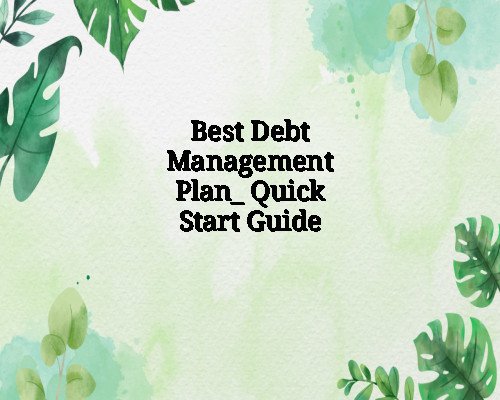Best Debt Management Plan: Quick Start Guide
Are you feeling overwhelmed by debt? A Debt Management Plan (DMP) might be the solution you need to regain control of your finances and pave the way to a debt-free future. This guide will help you understand what a Debt Management Plan is, how to get started, and the benefits it can offer.
What is a Debt Management Plan?
A Debt Management Plan (DMP) is a structured program designed to help individuals pay off unsecured debts, such as credit cards, medical bills, and personal loans. Through a DMP, you make a single monthly payment to a credit counseling agency, which then distributes the funds to your creditors. The main goal of a DMP is to reduce your overall debt burden by consolidating multiple payments into one, often with reduced interest rates or waived fees.
How Does a Debt Management Plan Work?
A DMP works by simplifying your debt payments and potentially reducing the interest rates or fees associated with your debts. Here’s how it typically works:
-
Consultation with a Credit Counselor: The first step is to meet with a certified credit counselor. They will review your financial situation, including your income, expenses, and total debt, to determine if a DMP is a viable solution for you.
-
Negotiation with Creditors: The credit counselor will contact your creditors and negotiate on your behalf. They may be able to secure lower interest rates, waive late fees, or even extend your repayment period.
-
Creating a Payment Plan: Based on your income and expenses, a repayment plan will be created. You’ll make one monthly payment to the credit counseling agency, which will then distribute the payments to your creditors.
-
Paying Off Your Debt: With a DMP in place, you’ll be on a clear path to paying off your debts. Depending on the amount of debt and the terms of the plan, it may take a few years to complete.
Benefits of a Debt Management Plan
There are several key benefits of using a Debt Management Plan:
1. Simplified Payments
Instead of juggling multiple payments to different creditors each month, you make just one payment to the credit counseling agency. This can help you stay organized and reduce the risk of missing a payment.
2. Reduced Interest Rates
One of the most significant advantages of a DMP is that your creditors may reduce your interest rates. This can significantly lower your monthly payments and save you money over time.
3. Waived Fees
Creditors may agree to waive late fees or penalties, which can quickly add up and make it harder to pay off your debts.
4. Improved Credit Score
By adhering to a Debt Management Plan, you show creditors that you are taking steps to pay off your debt. Over time, this can help improve your credit score, making it easier to access loans or credit in the future.
5. Financial Education
Many credit counseling agencies provide educational resources to help you manage your money more effectively in the future. This can include tips on budgeting, saving, and avoiding debt.
How to Start a Debt Management Plan
If you’re ready to take control of your debt, here’s a quick start guide to help you begin your DMP journey:
1. Assess Your Financial Situation
Before you reach out to a credit counselor, take a close look at your financial situation. List all your debts, including credit cards, personal loans, medical bills, and any other outstanding balances. Be honest about your income and expenses to understand how much you can afford to pay each month.
2. Find a Certified Credit Counseling Agency
Look for a reputable, non-profit credit counseling agency. Make sure they are accredited by organizations like the National Foundation for Credit Counseling (NFCC) or the Financial Counseling Association of America (FCAA). These organizations ensure that the agency adheres to ethical standards and offers reliable services.
3. Schedule a Consultation
Once you’ve found an agency, schedule a consultation with a certified credit counselor. They will assess your situation and determine whether a DMP is the right solution for you.
4. Create a Plan
If a DMP is right for you, the counselor will help you create a plan based on your financial situation. This will include your monthly payment amount, the duration of the plan, and the creditors involved.
5. Stick to the Plan
Once your DMP is in place, make sure to stick to the plan. Making your monthly payment on time is crucial to the success of the program. Avoid taking on additional debt during this period, as it can derail your progress.
How Long Does a Debt Management Plan Take?
The length of a Debt Management Plan can vary depending on the amount of debt you have and how much you can afford to pay each month. Typically, DMPs last anywhere from 3 to 5 years. However, some people may be able to pay off their debts in a shorter time frame, while others may need a longer plan to fully eliminate their debt.
Is a Debt Management Plan Right for You?
A DMP is a great option for people who are struggling with unsecured debt and are looking for a structured way to pay it off. However, it’s not suitable for everyone. If you’re dealing with secured debts (like a mortgage or car loan) or your debt is too large to handle through a DMP, you might need to explore other options, such as debt consolidation, debt settlement, or bankruptcy.
Before committing to a DMP, make sure to weigh the pros and cons and consult with a certified credit counselor. They will help you determine whether this path is the best option for your financial recovery.
Alternatives to Debt Management Plans
While a Debt Management Plan can be an effective solution for many, it’s not the only option available. If a DMP doesn’t seem right for you, here are some alternatives to consider:
1. Debt Consolidation Loan
If you have multiple debts with high-interest rates, you may consider a debt consolidation loan. This involves taking out a loan to pay off your existing debts, leaving you with a single loan payment. Consolidation loans can help you reduce your interest rates and simplify your payments.
2. Debt Settlement
Debt settlement involves negotiating with creditors to pay off a portion of your debt for less than the full amount. This option can be effective for people who are unable to pay off their debt in full but want to avoid bankruptcy. However, it can have a negative impact on your credit score and may result in tax consequences.
3. Bankruptcy
Bankruptcy is a last resort for people who are unable to repay their debts. While it provides a fresh start, it also comes with long-term consequences, including a significant drop in your credit score. It’s important to explore all other options before considering bankruptcy.
Conclusion
A Debt Management Plan is an effective way to regain control of your finances and pay off your debt. By consolidating your payments, reducing interest rates, and sticking to a structured repayment plan, you can become debt-free in just a few years. If you’re struggling with debt, reach out to a certified credit counselor to see if a DMP is the right solution for you.

